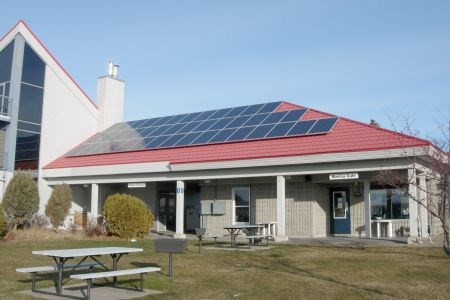The sunlight glinting off the roof of the Blind River municipal office brings a smile to Graeme Lowry's face.
Lowry, the CEO of North Shore Power Group Inc., knows that, with every sunny day, power —and profits — are being generated through the solar panels installed on town-owned buildings throughout the municipality.
Last fall, the town outfitted 11 of its buildings with the roof-mounted solar systems, and the community's residents were quick to follow.
Since Blind River embarked on a municipal microFIT program, secured through a $49.5-million municipal debenture from the Canada Mortgage and Housing Corporation's Municipal Infrastructure Lending Program, more than 400 applications have been submitted by residents and business owners seeking to participate in the venture.
It's the first such program in Ontario, and the municipality's contribution to the renewable energy revolution currently sweeping the province.
“It's a good program, and I think people want to participate, they want to be part of the green movement, and they want to support the government's initiative with the Green Energy Act,” Lowry said. “It's an opportunity for people to participate in the sector to make a little bit of money and to green their homes.”
There is capacity for 600 10-kilowatt project sites — or 1,500 homes — in the community, and the municipality covers the cost of the materials and installation, while the profits are shared by the town and the homeowner.
At a guaranteed return of 80.2 cents per kilowatt-hour for 20 years, participants stand to reap a generous benefit.
“The homeowner actually has the contract and the municipality is essentially financing the equipment for them,” Lowry said. “So the homeowner gets 10 per cent of the revenues, and then at the end of the contract they get the system for $1.”
Blind River has been exploring energy opportunities over the last two decades, but after a biomass project under the Renewable Energy Standard Offer Program (RESOP) fell through in 2008, solar seemed the way to go, Lowry said.
Last year, the town secured funding for a 120-acre solar field, but connection issues prevented the project from moving forward. That's when the town came up with the idea for the municipal microFIT program.
Of the 400 applications submitted, about 250 residents were offered contracts by the Ontario Power Authority (OPA), but connection constraints will only allow 100 to hook into the grid.
“They're just in a holding pattern right now, and Hydro One is so busy they haven't been able to get back to us as to what the issues are that are blocking those projects, and how we could do whatever's necessary to get those projects to go ahead,” he said.
The projects that have been greenlighted are being installed and connected this spring, Lowry said, and the remainder of homeowners are awaiting word from Hydro One on when their projects may proceed.
Success with the initiative has prompted the municipality to extend the program along the North Shore and projects are popping up from Iron Bridge to Spanish and north to Elliot Lake.
The initiative should result in about 100,000 hours of work during the construction phase, along with 10 permanent jobs, and work for the three companies contracted to manufacture and install the systems.
Menova Energy of Ottawa will install the ground-mounted solar systems, while Superior Energy Solutions and Canadian Geo and Solar, both of Sault Ste. Marie, will share the rooftop installation work.
The project has not been without its complications, however.
“Last fall, the steps for a project to proceed were that you apply to the OPA, you get a conditional offer, and then you apply to interconnect to Hydro One,” Lowry said. “In December they changed that because Hydro One started saying they were having problems with connecting people, so now you have to ask Hydro One first and if they say yes, then you have to ask the OPA for a contract.”
Because two-thirds of the projects were turned down by Hydro One, Menova's plans to build a staging facility are on hold indefinitely.
The municipality now plans to develop its own staging facility.
“We're still going to try to put together a staging facility in the industrial park, because we're chronically short of storage space and assembly space,” Lowry said. “There isn't any in Blind River — we've rented every warehouse there is — so the Blind River Development Corporation is taking a look at putting together a building that they would lease to all the companies involved in this project.”
The town isn't giving up on its solar field either.
“We're all engineered and ready to go,” Lowry says, noting that 100 acres has been cleared and prepped for development. “We're ready, we're invested, and we would like to deliver energy to the grid, but at the moment the bureaucracy isn't letting us.”
The project currently sits at priority number 15 on the economic connection test (ECT) list, awaiting word from Hydro One, which won't likely come until June. If the solar field is eventually approved, it will find a home in the industrial park, but in the meantime, the town will welcome other development to its community.
“I think Blind River should be proud of the initiative it's taken,” Lowry said. “It's the future. I think the renewables are an important part of tomorrow's power solution.”




